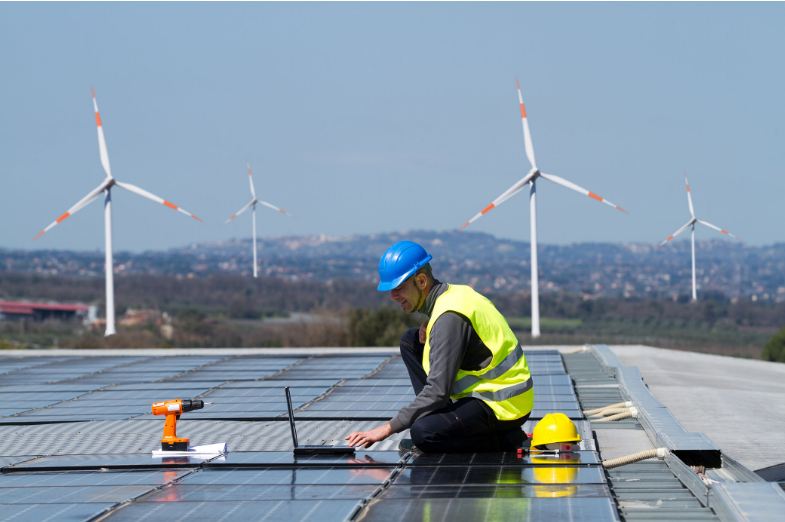Make Your Home Steady Light with Solar Power | In this guide, we’ll delve into the workings of solar energy systems, exploring the process of harnessing sunlight to generate electricity and its implications for the American energy landscape. Read through
Make Your Home Steady Light with Solar Power
Solar energy has emerged as a pivotal component of the renewable energy landscape in the United States, offering clean, sustainable power solutions with immense potential for reducing carbon emissions and mitigating climate change.
Understanding how solar power works in the USA is essential for appreciating its benefits, challenges, and widespread adoption across residential, commercial, and utility-scale applications.
Photovoltaic (PV) Technology:
At the heart of solar energy systems lies photovoltaic (PV) technology, which converts sunlight directly into electricity using semiconductor materials such as silicon. When sunlight strikes the surface of a solar panel, it excites electrons within the semiconductor material, creating an electric current.
This phenomenon, known as the photovoltaic effect, forms the basis of solar energy generation in PV systems.
Solar Panels and Arrays:
Solar panels, also known as solar modules, consist of multiple interconnected solar cells housed within a protective frame. Solar panels are typically arranged in arrays on rooftops, ground-mounted structures, or solar farms to maximize sunlight exposure and electricity generation.
In the USA, residential and commercial properties often install rooftop solar panels to offset electricity consumption and reduce utility bills, while utility-scale solar farms contribute to grid-scale power generation and renewable energy integration.
Inverters and Power Conversion:
Solar panels produce direct current (DC) electricity, which must be converted into alternating current (AC) electricity for use in homes, businesses, and the electric grid. Inverters play a critical role in this process by converting the DC electricity generated by solar panels into AC electricity compatible with standard electrical appliances and grid infrastructure.
Inverters also perform functions such as voltage regulation, synchronization with the grid, and data monitoring to ensure optimal system performance and efficiency.
Net Metering and Grid Integration:
One of the key benefits of solar energy systems in the USA is net metering, a billing arrangement that allows solar panel owners to receive credit for excess electricity generated by their systems and exported to the grid.
Under net metering policies, homeowners and businesses can offset their electricity bills by selling surplus solar power to utilities at retail or wholesale rates, depending on state regulations. This incentive encourages widespread adoption of solar energy and promotes grid stability by integrating distributed renewable energy resources into the electric grid.
Solar Energy Storage:
As solar energy continues to proliferate across the USA, energy storage technologies such as batteries play an increasingly vital role in maximizing the value and reliability of solar power systems. Solar energy storage enables homeowners, businesses, and utilities to store excess solar energy generated during the day for use during periods of high demand, grid outages, or when sunlight is unavailable.
Battery storage systems enhance energy independence, grid resilience, and the economic viability of solar power, particularly in regions with variable weather conditions or time-of-use electricity pricing.
Policy Support and Market Growth:
The growth of solar energy in the USA is fueled by supportive policies, incentives, and market dynamics at the federal, state, and local levels. Federal tax credits, state rebates, renewable portfolio standards (RPS), and utility incentive programs incentivize solar adoption, drive innovation, and stimulate investment in clean energy infrastructure.
Additionally, declining costs of solar panels, advances in technology, and growing public awareness of environmental and economic benefits contribute to the rapid expansion of solar power capacity nationwide.
Conclusion:
Solar energy plays a pivotal role in the USA’s transition to a clean, sustainable energy future, offering abundant, renewable power solutions with significant environmental, economic, and social benefits.
By harnessing sunlight through photovoltaic technology, solar energy systems generate electricity for homes, businesses, and communities while reducing carbon emissions, enhancing energy security, and creating jobs.
As solar power continues to gain momentum and affordability, its integration into the American energy landscape holds promise for a brighter, more sustainable future for generations to come.
Illuminating Pathways: How to Become a Solar Panel Installer in the USA



